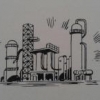Dear all,
I am a project engineer. Recently, in one of our brownfield EPC project, we were contemplating installation of chemical dosing tanks ( 3 m dia x 4 m length) in a vertical configuration, as there was a space limitation. We were prepared to
bear all the costs related to increased shelter height on account of the vertical configuration.
The client flatly refused and stated that as per good engineering practice; the dosing tanks have to be horizontal.
We, the EPC contractors, had no option but to negotiate and purchase small portion of land from the adjoining organisation (in order to accommodate the horizontal tanks) ;as the locations of the tanks on the approved congested plot plan was at the edge of the plot
For my academic knowledge, I hereby request the forum members to please advise me the reasons for having the dosing tanks in a hoizontal configuration.
Thank you.

 FB
FB













